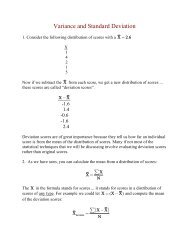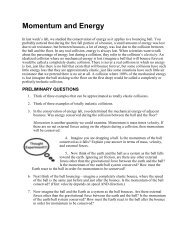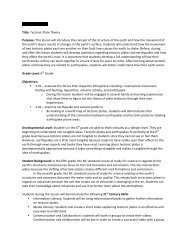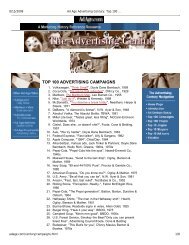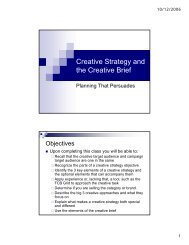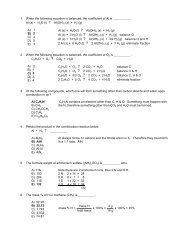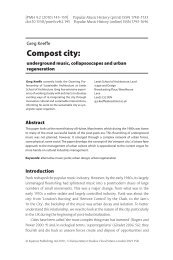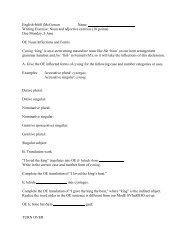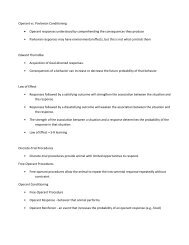How to Read a Research Article
How to Read a Research Article
How to Read a Research Article
You also want an ePaper? Increase the reach of your titles
YUMPU automatically turns print PDFs into web optimized ePapers that Google loves.
<strong>How</strong> <strong>to</strong> <strong>Read</strong> a <strong>Research</strong> <strong>Article</strong><br />
A. First, read the Abstract. Do not believe everything you read in the abstract ... read it <strong>to</strong> get a<br />
general idea about the study: what is <strong>to</strong>pic and how did the authors go doing about their research.<br />
B. Second, read the Introduction trying <strong>to</strong> answer the following questions:<br />
1. What was the purpose for doing the study<br />
2. What are the primary dependent and independent variables in the study (you might have<br />
<strong>to</strong> wait until you get <strong>to</strong> the Method section <strong>to</strong> find out how these variables were<br />
operationally defined)<br />
3. What were the author’s hypotheses concerning the relationships that might exist between<br />
the independent and dependent variables<br />
C. After answering the questions in part B, and not before, read the entire Method section over<br />
quickly and determine if the reported study represents an experiment or a non-experimental<br />
study. After you have figured this out go back and carefully read the Method section:<br />
1. <strong>Read</strong> the Participant section: Who were the subjects, are they representative of some<br />
population (was the sample a convenience sample or a probability sample), <strong>to</strong> what<br />
extent might the subject sample limit the generality of possible results<br />
2. <strong>How</strong> were the variables in the study operationally defined (measured). Were the<br />
operational definitions adequate (reliable, valid, relevant) and can you think of other<br />
ways <strong>to</strong> operationally define the variables<br />
3. What was the design of the study<br />
4. <strong>How</strong> and where was the study done There will probably be a “Procedures” section<br />
where this information will be available.<br />
5. Now before you do anything else, ask yourself:<br />
a) if the study was an experiment, is there any chance the study could be confounded<br />
and if so how might that have happened<br />
b) if the study was a non-experimental study, ask yourself about third<br />
variables that might be operating in the study and try <strong>to</strong> identify any possible<br />
directionality problems<br />
c) do you think that the study was designed and carried out in such a way that the<br />
results of the study might shed light on the hypotheses that you identified from<br />
reading the Introduction<br />
D. <strong>Read</strong> the Results section: reading the Results might be difficult but in most cases you can skip<br />
over the statistical details and look for the authors’ conclusions regarding the results of their<br />
statistical analyses.<br />
1. If there are charts or figures in the report try <strong>to</strong> interpret them ... they can often help you<br />
understand the results even when you are not familiar with the inferential statistical<br />
methods used by the authors.<br />
2. What do the results tell you about the hypotheses that you identified when you read the<br />
Introduction<br />
3. Are there additional analyses that might be of interest<br />
E. <strong>Read</strong> the Discussion section but be very careful ... do not believe everything the authors tell
you ... read this section critically. DO NOT READ the Discussion section until you have<br />
completed tasks A through D.<br />
1. <strong>How</strong> do the authors interpret the results of their study... Do you agree with them<br />
2. What implications do the authors draw for future research or perhaps public policy ...<br />
were these inferences reasonable given the results and scope of the study<br />
3. All studies without exception have limitations. The authors should always discuss the<br />
limitations of their study. Identify these limitations. (If the authors have failed <strong>to</strong> discuss<br />
the limitations of their research that should be noted and you should be skeptical of their<br />
claims about the results of the study)<br />
4. Now you might want <strong>to</strong> go back and read the study a second time following steps A<br />
through D.... Repeat until you are sure that you understand the study.



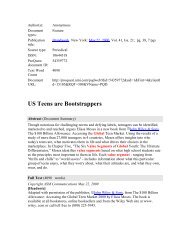

![Graduate Bulletin [PDF] - MFC home page - Appalachian State ...](https://img.yumpu.com/50706615/1/190x245/graduate-bulletin-pdf-mfc-home-page-appalachian-state-.jpg?quality=85)
